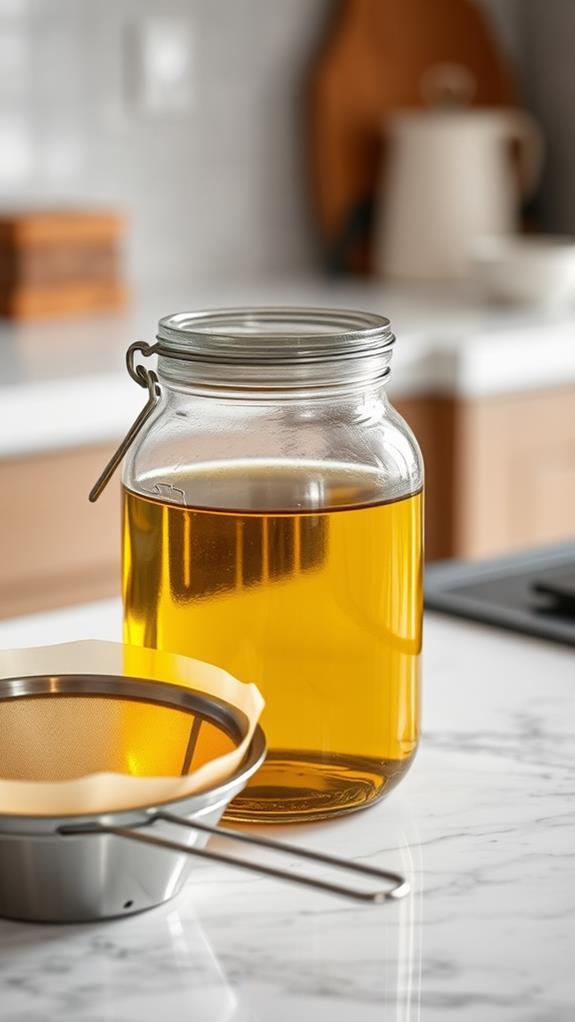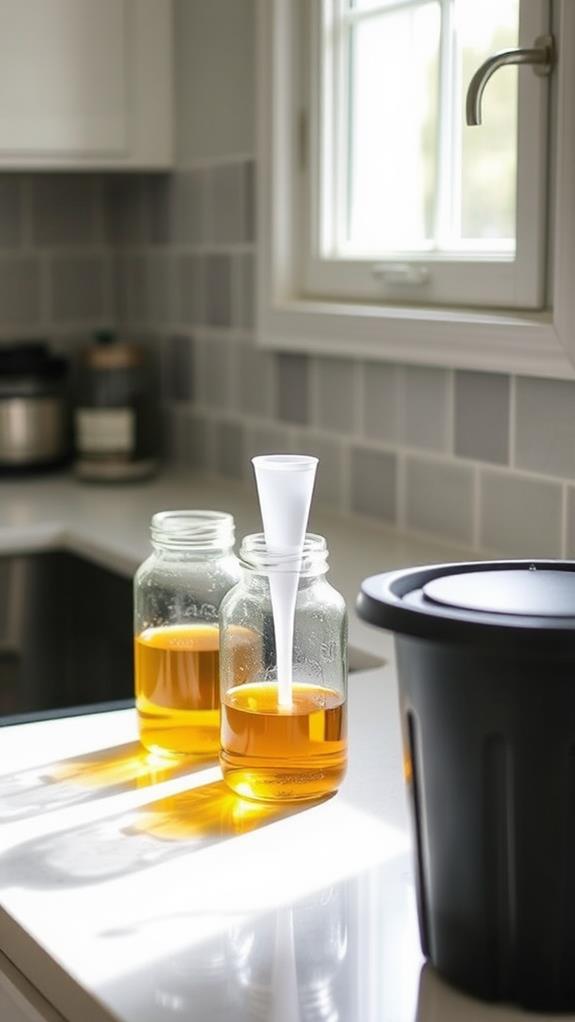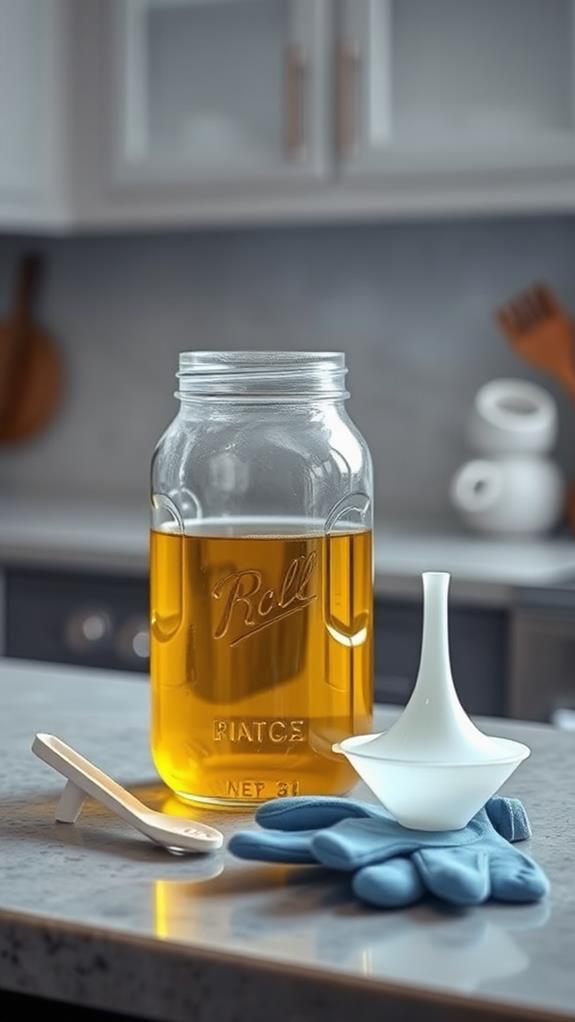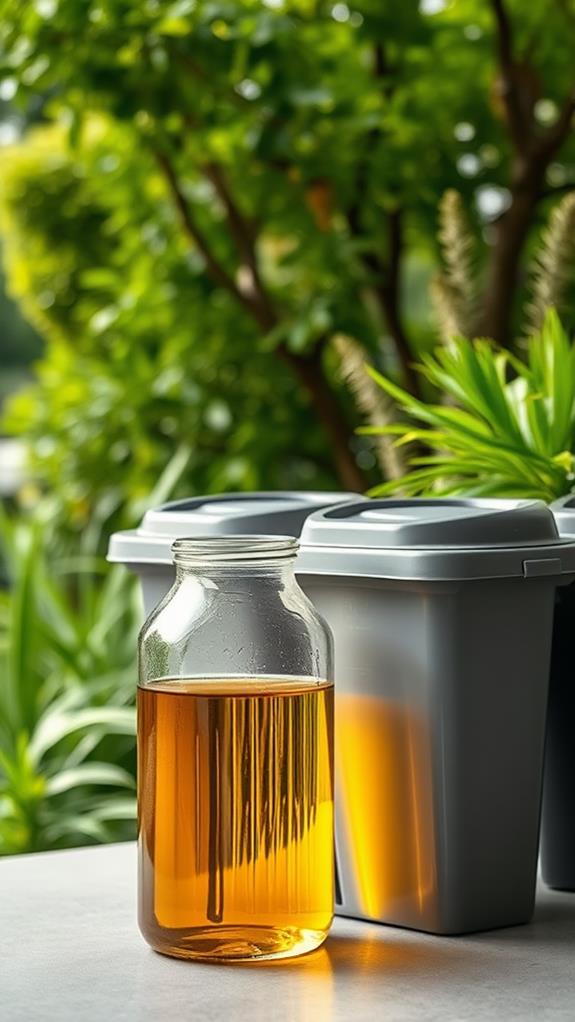What to Do With Leftover Cooking Oil
When dealing with leftover cooking oil, you've got several options. First, allow it to cool completely and strain out any food particles. You can reuse filtered oil for similar cooking tasks, but discard it if it smells off or changes color. For disposal, don't pour it down the drain. Instead, mix cooled oil with absorbent materials like coffee grounds before trashing it, or check for local recycling programs. Get creative by repurposing the oil for household tasks like polishing wood or lubricating hinges. Always handle cooled oil carefully and store it in airtight containers. Proper management of used cooking oil extends beyond the kitchen.
This post may contain affiliate links. If you make a purchase through these links, I may earn a commission at no additional cost to you. Additionally, portions of this post may be generated using artificial intelligence (AI) technology. While we strive for accuracy, please be aware that AI-generated content may not always be perfect and should be fact-checked when necessary.
The Spatula Scoops
- Cool and strain used cooking oil before storing in an airtight container in a cool, dark place.
- Filter the oil through a fine-mesh sieve and coffee filter to remove impurities before reusing.
- Repurpose used oil for creative household uses like wood polish, bird feed, or garden pest deterrent.
- Dispose of oil responsibly by mixing with absorbent materials or using local recycling programs.
- Never pour cooking oil down the drain; allow it to cool completely before handling or disposing.
Proper Cooling and Storage

Safety first: When dealing with leftover cooking oil, proper cooling and storage are essential. After cooking, allow your used cooking oil to cool completely to room temperature. This step is indispensable to prevent burns and guarantee safe handling. Once cooled, strain the oil to remove any food particles or debris.
Next, transfer the strained oil into a clean, airtight container. A glass jar works best for this purpose. For optimal storage, consider using airtight glass jars with measurement marks, which can help you keep track of the oil quantity. Choose a cool, dark place to store your oil, away from heat sources like ovens, refrigerators, or microwaves. These appliances generate heat, which can accelerate oil degradation.
To extend the shelf life of your stored oil, consider refrigerating or freezing it. This helps maintain its quality and freshness for longer periods. Remember, proper storage conditions are key to preserving the oil's usability. Keep it in a cool environment with limited air exposure to prevent oxidation.
Filtering and Reusing Oil

To reuse your cooking oil safely, you'll need to filter it properly and store it correctly. Start by straining the cooled oil through a fine mesh strainer or coffee filter to remove any food particles that could cause the oil to spoil faster. Implementing a FIFO system for your cooking oil can help guarantee you use older batches first, reducing the risk of rancidity. Once filtered, store your oil in an airtight container, preferably in the refrigerator or freezer, to extend its shelf life and maintain its quality for future use.
Proper Straining Techniques
When you've finished frying up a delicious meal, don't let that valuable cooking oil go to waste. Proper straining techniques can help you reuse your cooking oil multiple times, saving money and reducing waste.
To begin, strain the used oil through a fine-mesh sieve or cheesecloth to remove any visible food particles. This initial step is indispensable for eliminating larger debris. For even better results, you can pour the oil through a coffee filter, which will capture smaller impurities that might have slipped through the first straining process.
Once you've strained the oil, store it in an airtight container. Choose a cool, dark place for storage to minimize exposure to light and air, which can accelerate spoilage. This careful storage method will help extend the oil's lifespan.
You can reuse this filtered oil for similar frying tasks, but always check its quality before each use. If you notice any off smells, unusual colors, or changes in consistency, it's time to discard the oil. By following these proper straining and storage techniques, you'll be able to maximize the use of your cooking oil while maintaining food safety and quality.
Oil Storage Methods
Proper storage is the key to extending the life of your used cooking oil. After straining your leftover cooking oil, you'll want to transfer it to an airtight container. Glass jars work well for this purpose, as they don't interact with the oil. Once you've sealed your container, store it in a cool, dark place to slow down oxidation.
For even longer storage, you can refrigerate or freeze your used oil. This further slows the oxidation process, helping to maintain its quality. When you're ready to reuse the oil, let it come to room temperature before frying.
Here's a quick reference guide for storing your used cooking oil:
| Storage Method | Container Type | Location | Duration |
|---|---|---|---|
| Room Temperature | Airtight Glass Jar | Cool, Dark Place | 1-3 months |
| Refrigeration | Airtight Container | Refrigerator | 3-6 months |
| Freezing | Freezer-Safe Container | Freezer | 6-12 months |
| Short-Term | Original Bottle | Pantry | 1-2 weeks |
| Long-Term | Vacuum-Sealed Bag | Freezer | Up to 1 year |
Remember to check your stored oil before reusing it. If it's discolored, cloudy, or has an off-odor, it's best to discard it.
Eco-Friendly Disposal Methods

Environmental responsibility extends to the disposal of leftover cooking oil. You'll want to avoid pouring it down the drain, as this can cause clogs and harm the environment. Instead, consider eco-friendly disposal methods that minimize your impact on the ecosystem. One sustainable option is to reuse the oil for pickling vegetables in an airtight glass jar, which can help reduce waste and extend the oil's usefulness.
One option is to recycle your cooking oil. Many cities have grease disposal systems or cooking oil recycling programs. Check with your local solid waste management department to see if they offer this service. If they do, you can usually drop off your used oil at designated collection points.
For small amounts of oil, you can dispose of it in your regular trash. However, it's important to follow these steps:
- Let the oil cool completely
- Mix it with absorbent materials like coffee grounds or cat litter
- Place it in a sealed, disposable container
If you have large quantities of oil or it's contaminated with chemicals, it may be considered hazardous waste. In this case, you'll need to contact your local waste management facility for proper disposal instructions. Remember, essential disposal of cooking oil is vital for protecting our environment and maintaining our sewage systems.
Creative Repurposing Ideas

Leftover cooking oil doesn't have to be a waste. If you've been wondering what to do with used frying oil, there are several creative ways to repurpose it. Before you dispose of your cooking oil, consider these innovative ideas.
First, you can create a natural wood polish by mixing leftover oil with lemon juice or vinegar. This combination will give your wooden furniture a fresh shine. If you're a bird enthusiast, you can add small amounts of used cooking oil to bird feeders, providing wild birds with essential calories and nutrients.
For a DIY spa treatment, combine the oil with salt or coffee grounds to make a homemade skin exfoliator. If you're dealing with garden pests, pour the used oil around your garden's perimeter to deter insects and small animals.
Lastly, if you plan to reuse the oil for household maintenance, let it cool completely before applying it to squeaky hinges or stuck zippers. Remember, when disposing of used cooking oil, always let it cool first and pour it into a sealable container to prevent spills and minimize environmental impact.
Safety Precautions for Handling

Safety should be your top priority when handling leftover cooking oil. First and foremost, let the oil cool completely before you attempt to handle it. This process takes about a day, so be patient. While you wait for the oil to cool, prepare your workspace. You'll need to strain the oil and dispose of it properly, so gather the necessary materials.
When you're ready to handle the oil, wear heat-resistant gloves to protect your hands from any residual heat. Carefully transfer the cooled oil into a sturdy, sealable container for proper disposal. Remember, you should never pour hot oil down the sink drain, as it can solidify and clog pipes.
Here are some additional safety tips:
- Keep oil away from children and pets during the cooling process.
- Use paper towels to clean up any spills immediately.
- Exercise caution when transporting containers of used oil to prevent leaks.
As you dispose of frying oil, remember that safety comes first. By following these precautions, you'll protect yourself and your home from potential accidents. Always prioritize your well-being when handling leftover cooking oil, and you'll be able to manage it safely and efficiently.
Environmental Impact Considerations

A pivotal aspect of handling leftover cooking oil is understanding its environmental impact. When you pour oil down the drain or dispose of cooking oil improperly, you're contributing to serious environmental issues. Oil can clog pipes, pollute waterways, and harm aquatic ecosystems. It's imperative to know that oil down the drain can lead to costly repairs and environmental damage.
Instead of throwing away your used oil, consider these environmentally friendly options:
| Method | Benefits | Considerations |
|---|---|---|
| Recycling | Reduces waste, creates biodiesel | Find local recycling centers |
| Composting | Enriches soil, reduces landfill waste | Only for small amounts |
| Reusing | Saves resources, reduces waste | Guarantee oil hasn't gone bad |
| Proper disposal | Prevents environmental damage | Follow local guidelines |
Frequently Asked Questions
What Can I Do With Left Over Cooking Oil?
You've got several options for your leftover cooking oil. First, you can store it in an airtight container and reuse it 2-3 times for similar dishes. If you're done with it, dispose of it safely by pouring it into a non-recyclable container and tossing it in the trash. For an eco-friendly approach, take it to a local recycling center for biodiesel conversion. Alternatively, mix it with absorbent materials before disposal, or get creative by using it for bird food or homemade soap.
How to Dispose of Cooking Oil After Frying?
After frying, you'll want to dispose of your cooking oil properly. First, let it cool completely. Then, you've got a few options. You can pour it into a non-recyclable container with a lid and toss it in the trash. Alternatively, freeze the oil until it solidifies, then throw it away. You might also mix it with absorbent materials like cat litter before disposal. For larger amounts, consider pouring it gradually into a trash bag with paper towels. Always check local guidelines for specific disposal methods.
Is There a Way to Reuse Cooking Oil?
Yes, you can reuse cooking oil. After frying, let the oil cool completely, then strain it through a fine-mesh sieve or cheesecloth to remove food particles. Store it in an airtight container in a cool, dark place. You can reuse it several times, depending on what you've cooked. However, be aware that oil degrades with each use. If it smells rancid, appears dark, or has visible sediment, it's time to dispose of it properly.
Can You Pour Cooking Oil in the Grass?
Visualize this: you pour cooking oil on your grass, thinking it's harmless. You'd be mistaken. Don't pour cooking oil on the grass. It's harmful to the environment and can damage your lawn. The oil creates a barrier that prevents water and air from reaching the roots. It can also contaminate the soil, attract pests, and disrupt the ecosystem. Instead, dispose of cooking oil properly by recycling it or placing it in a sealed container in the trash.





